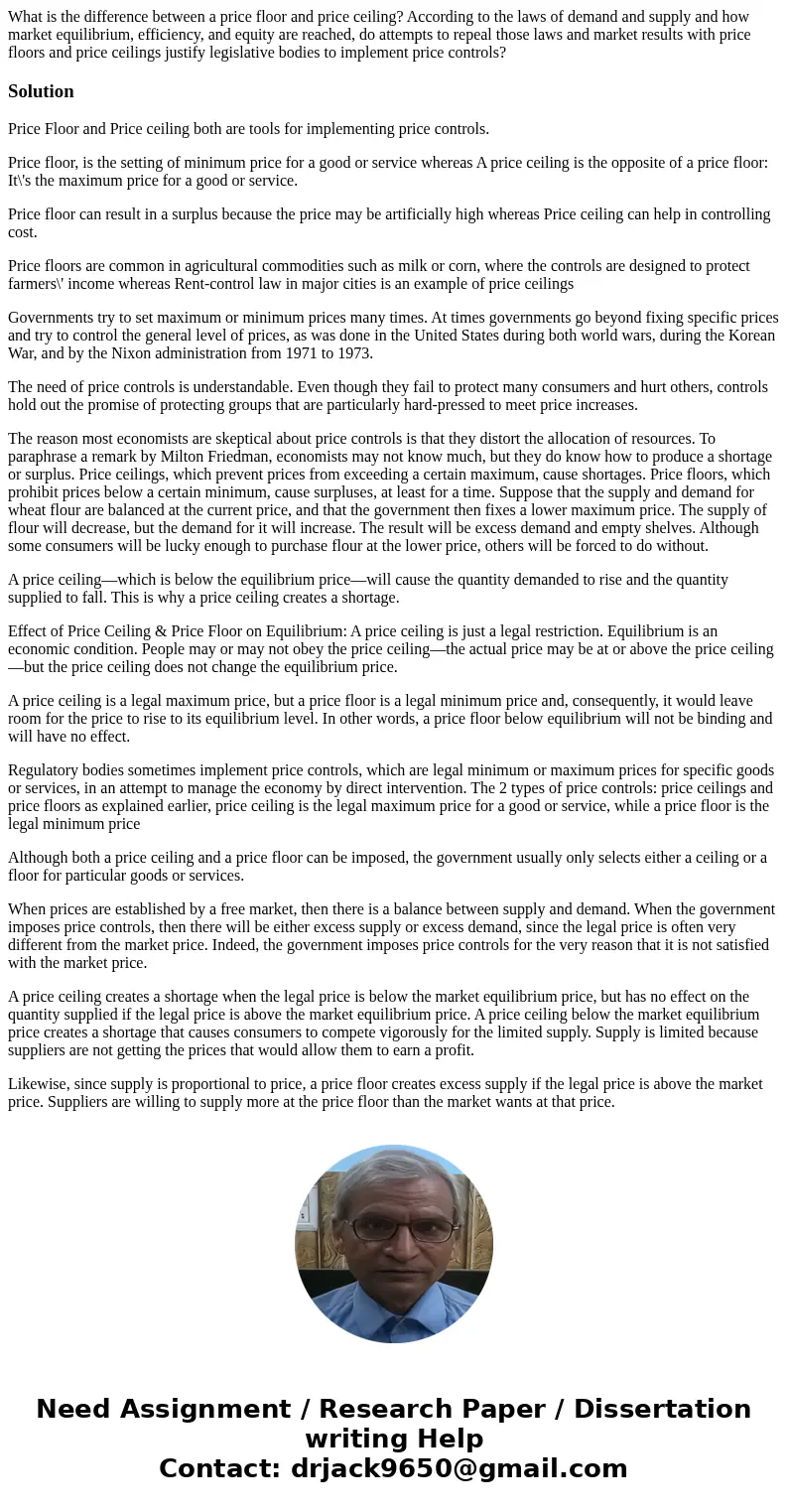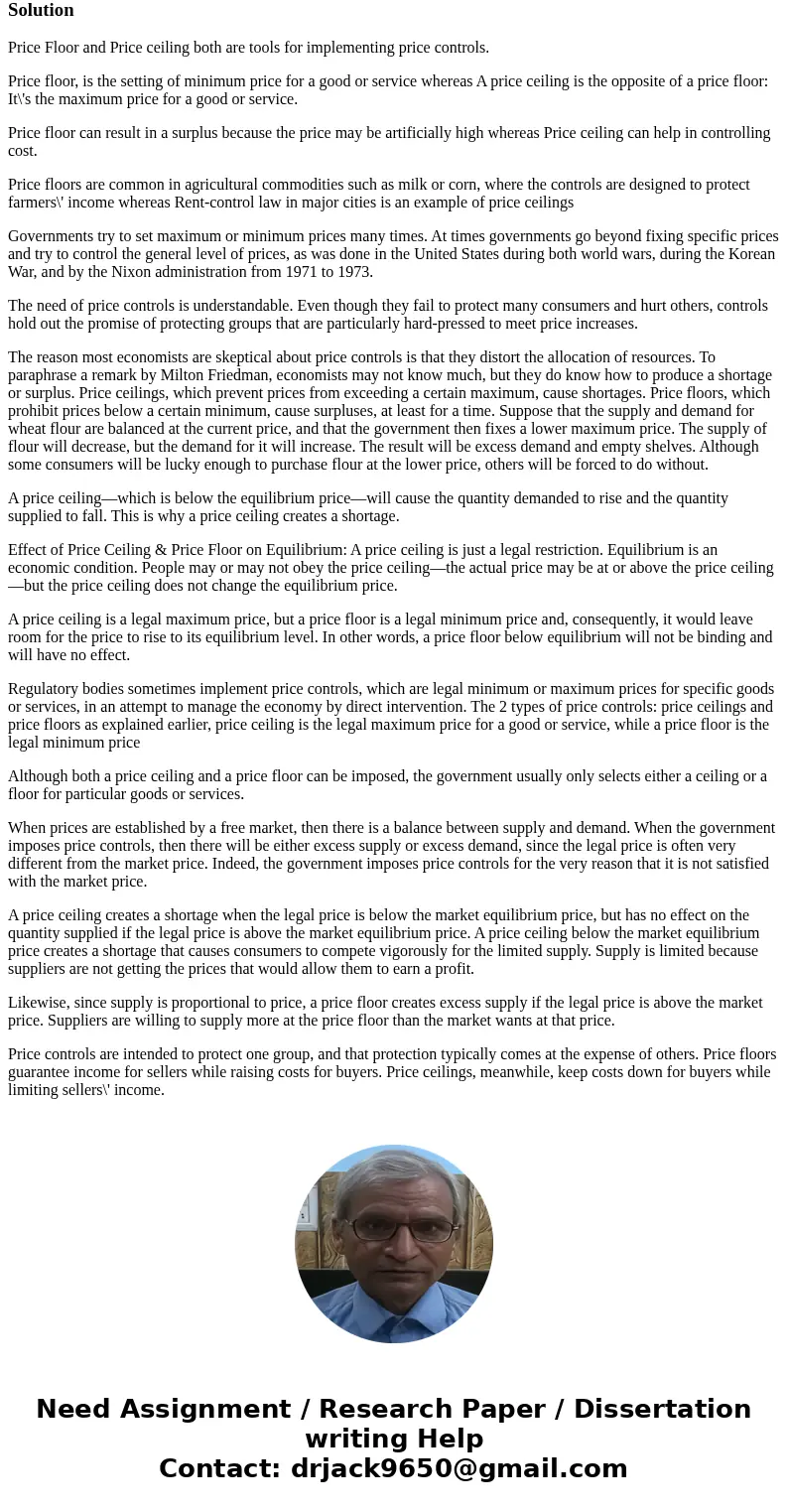What is the difference between a price floor and price ceili
What is the difference between a price floor and price ceiling? According to the laws of demand and supply and how market equilibrium, efficiency, and equity are reached, do attempts to repeal those laws and market results with price floors and price ceilings justify legislative bodies to implement price controls?
Solution
Price Floor and Price ceiling both are tools for implementing price controls.
Price floor, is the setting of minimum price for a good or service whereas A price ceiling is the opposite of a price floor: It\'s the maximum price for a good or service.
Price floor can result in a surplus because the price may be artificially high whereas Price ceiling can help in controlling cost.
Price floors are common in agricultural commodities such as milk or corn, where the controls are designed to protect farmers\' income whereas Rent-control law in major cities is an example of price ceilings
Governments try to set maximum or minimum prices many times. At times governments go beyond fixing specific prices and try to control the general level of prices, as was done in the United States during both world wars, during the Korean War, and by the Nixon administration from 1971 to 1973.
The need of price controls is understandable. Even though they fail to protect many consumers and hurt others, controls hold out the promise of protecting groups that are particularly hard-pressed to meet price increases.
The reason most economists are skeptical about price controls is that they distort the allocation of resources. To paraphrase a remark by Milton Friedman, economists may not know much, but they do know how to produce a shortage or surplus. Price ceilings, which prevent prices from exceeding a certain maximum, cause shortages. Price floors, which prohibit prices below a certain minimum, cause surpluses, at least for a time. Suppose that the supply and demand for wheat flour are balanced at the current price, and that the government then fixes a lower maximum price. The supply of flour will decrease, but the demand for it will increase. The result will be excess demand and empty shelves. Although some consumers will be lucky enough to purchase flour at the lower price, others will be forced to do without.
A price ceiling—which is below the equilibrium price—will cause the quantity demanded to rise and the quantity supplied to fall. This is why a price ceiling creates a shortage.
Effect of Price Ceiling & Price Floor on Equilibrium: A price ceiling is just a legal restriction. Equilibrium is an economic condition. People may or may not obey the price ceiling—the actual price may be at or above the price ceiling—but the price ceiling does not change the equilibrium price.
A price ceiling is a legal maximum price, but a price floor is a legal minimum price and, consequently, it would leave room for the price to rise to its equilibrium level. In other words, a price floor below equilibrium will not be binding and will have no effect.
Regulatory bodies sometimes implement price controls, which are legal minimum or maximum prices for specific goods or services, in an attempt to manage the economy by direct intervention. The 2 types of price controls: price ceilings and price floors as explained earlier, price ceiling is the legal maximum price for a good or service, while a price floor is the legal minimum price
Although both a price ceiling and a price floor can be imposed, the government usually only selects either a ceiling or a floor for particular goods or services.
When prices are established by a free market, then there is a balance between supply and demand. When the government imposes price controls, then there will be either excess supply or excess demand, since the legal price is often very different from the market price. Indeed, the government imposes price controls for the very reason that it is not satisfied with the market price.
A price ceiling creates a shortage when the legal price is below the market equilibrium price, but has no effect on the quantity supplied if the legal price is above the market equilibrium price. A price ceiling below the market equilibrium price creates a shortage that causes consumers to compete vigorously for the limited supply. Supply is limited because suppliers are not getting the prices that would allow them to earn a profit.
Likewise, since supply is proportional to price, a price floor creates excess supply if the legal price is above the market price. Suppliers are willing to supply more at the price floor than the market wants at that price.
Price controls are intended to protect one group, and that protection typically comes at the expense of others. Price floors guarantee income for sellers while raising costs for buyers. Price ceilings, meanwhile, keep costs down for buyers while limiting sellers\' income.


 Homework Sourse
Homework Sourse